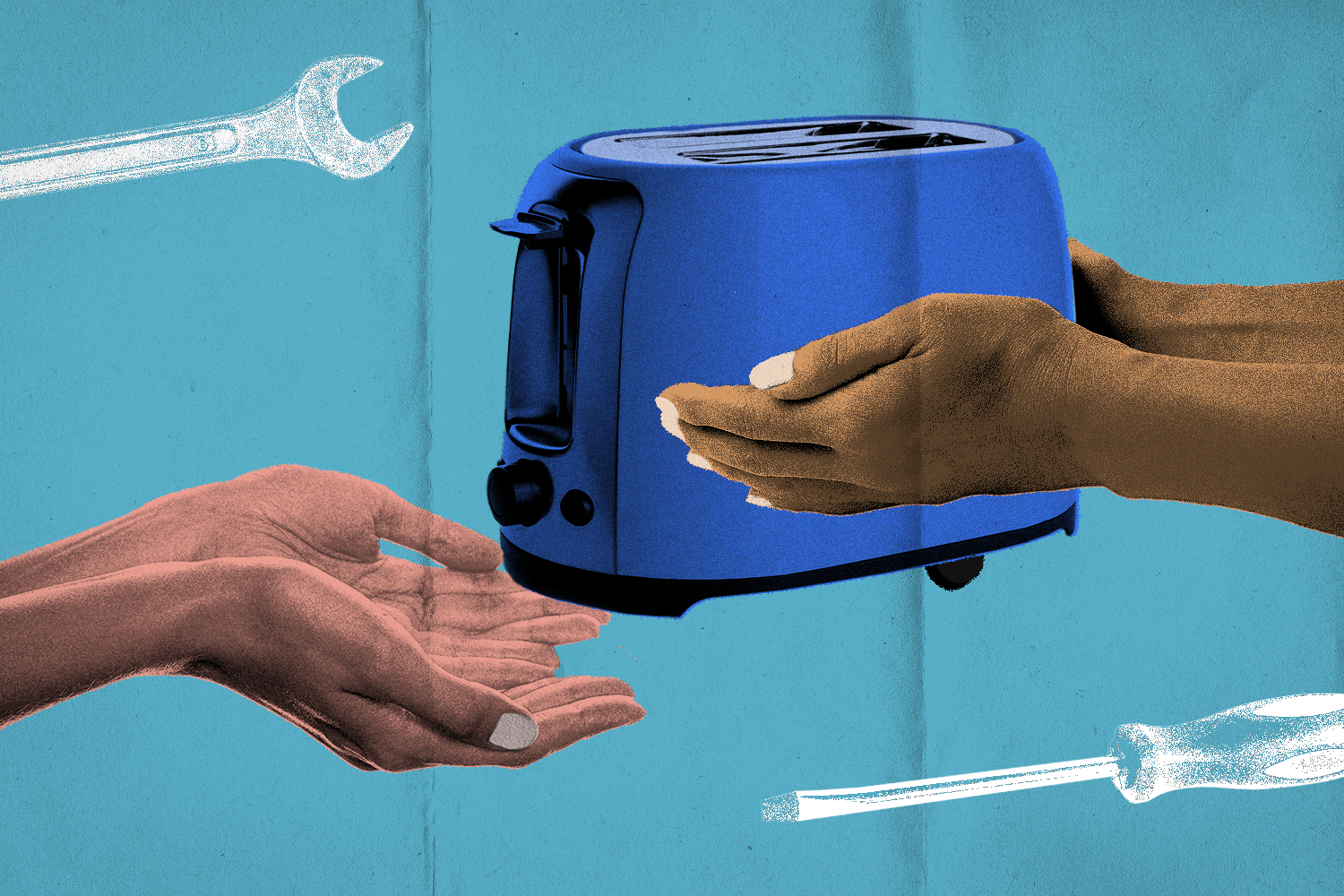
June 2nd, 2025
Hey team, and welcome back to one5c! Indulge me for a second while I talk about my dishwasher. It came with the apartment when I moved in 12-plus years ago, and long-about 2021 it just quit—right before Thanksgiving dinner, no less. I called a local tech, and three visits, five parts, and hundreds of dollars later, that sucker is still humming. At one point, the dispatcher tried to talk me into buying a new machine instead of a second wave of parts, but I refused.
At the time, I was trying to avoid the headache of wiggling a new appliance into the narrowest of New York City kitchens, but I was dug in on doing the planet a favor, too. Turns out, if more of us commit to our appliances, the gains start to really add up. Scroll on past the digest for a full rundown from Tyler on the impacts of repairing what we’ve already got. —Corinne
WHAT WE’RE INTO THIS WEEK
By Sara Kiley Watson

Report card
U.S. paper mills leave an underreported footprint
In 2023, paper mills emitted some 115 million metric tons of greenhouse gases—but only 33 million of that was reported by the EPA, according to new research from nonprofit watchdog Environmental Integrity Project. The loophole those gases snuck through? Industries are allowed to subtract emissions from “biogenic” fuels, including a wood waste product called black liquor. About half of the 185 mills the authors looked at burn it—and another 38 tap fuel like coal, tires, or petroleum coke. Not to mention, paper mills are among the largest polluters of hydrogen sulfide, a toxic, flammable gas that can cause conjunctivitis and respiratory problems at low levels. But! There is something we as individuals can do with this information: Buy fewer paper products when you can (we love a reusable towel) and, when it’s unavoidable, like with toilet paper, opt for recycled over new.
Cause for optimism
All aboard the EV bandwagon
According to research firm Escalent, 70% of electric vehicle owners are men. But driving a sustainable ride needn’t be a boy’s club—in fact, the earliest iterations of EVs from the 1900s were actually geared toward women. Virginia-based nonprofit Generation180 has a novel approach to getting suburban ladies in on the switch. Its “I’ll Drive What She’s Driving” campaign centers on a team of 7,000 EV ambassadors: women with EV experience willing to share their stories with other “EV-curious” folks. Even as policy on the state and federal level grows increasingly shaky for electric whips, the “trusted messengers and the clean energy constituencies that we’re building, those have real staying power,” Stuart Gardner, Generation180’s executive director, tells Canary Media.
Good read
The fuzzy reality of AI’s energy demands
ChatGPT is among the top five websites in the world, a fact that raises alarm bells for both climate scientists and sustainability-minded individuals. While perhaps fun for generating pictures of your cat as a medieval king, getting a quick rundown on a topic, or planning out a vacation itinerary, AI is frightening from a planet-warming perspective because there’s not a whole lot of clarity about how much energy these little tricks actually use. This explainer from MIT Technology Review is the most comprehensive dive into the math we’ve seen to date. In it, authors Casey Crownhart and James O’Donnell run down the variables that determine the emissions of a range of queries. Even so, there’s only so much math we can reasonably do at this point: There’s still a lot we don’t know about how popular AI models like ChatGPT process individual queries, for example. What we do know, however, is that the data centers they rely on are largely powered by fossil fuels and that AI is creeping into all corners of our lives.
Accountability check
Lawsuits target the Trump administration and Big Oil
A group of 22 Americans and nonprofit law firm Our Children’s Trust are suing the federal government over what they call violations to their constitutional rights to life and liberty. Lead plaintiff Eva Lighthiser, who was also part of the landmark Held v. Montana case, says executive orders that boost fossil fuel development and avoid mitigation and adaptation spell a death sentence for the current generation of young people. The goal of the lawsuit is to declare three executive orders—specifically, the acts that declared a “national energy emergency,” called to “unleash American energy,” and reinvigorated domestic production of coal—unconstitutional and block their implementation. This isn’t the only lawsuit we have our eyes on: Seven different fossil fuel companies were just sued for the wrongful death of a woman in a 2021 heat wave, representing the growing call to hold major emitters accountable for making the planet increasingly dangerous.
Product Review
The best Swedish dishcloth
As a paper towel replacement, these absorbent and easy-to-clean cloths are tough to beat. Check out our top pick.

EYEBROW
Headline
By some really smart folks

We know there are more than a handful of ways we can make a major dent in our individual shares of planet-warming emissions: flying less, driving less, and eating less meat are among the biggies. A new study in Nature Communications finds that the world’s top emitters—about 23.7% of the total population—can collectively stop 10.4 gigatons of CO2 from hitting the atmosphere per year by adopting less-emitting habits. That’s about one-quarter of annual global CO2 emissions.
One less-common tactic the authors found? Stop trashing old appliances. Initiatives that boost “sharing and repairing” of dishwashers, refrigerators, ovens, laundry machines, and more can reduce per capita household emissions by 3%—which might sound small, but small wins add up. Besides, it’s not hard to do. The obvious thing to do here is call a pro when something breaks, but warranties from manufacturers and retailers can be confusing and unreliable—and repair techs can be pricey and sometimes pretty iffy. Here’s five other ways to share and repair appliances.
1. DIY basic fixes
Even people who don’t consider themselves expert DIYers can tackle some common appliance problems. Some easy fixes: leaky dishwashers, clogged garbage disposals, and washing machines that refuse to spin. If you’re more experienced, check out the guides from Repair Cafe on fixing everything from kitchen appliances to electric heaters. You can also try following along with repair videos, like those from Bearded Appliance Repair. Proceed with caution, though: If a product is still under warranty, working on it yourself could void that contract.
2. Find a local repair group
In many areas, expert volunteers will help fix broken appliances during free repair events. The group Repair Cafe, for instance, has more than 3,600 chapters in dozens of countries, so they’re the best place to start your search. You can also look for local “Share and Repair” groups; lucky for Brits, the biggest one is in the UK, but they can be found all over—it’s as easy as plugging “repair group near me” into Google. Some local governments, such as ones in Vancouver and Austin, also host share and repair events.
3. Share with your community
In some areas, you can borrow gear for short-term use from tool libraries for free or at a low cost. Many lenders also provide workspace, workshops, and classes. Of course, borrowing isn’t an option for things like refrigerators and dishwashers, but it can be great for items you only need occasionally: like a saw for a carpentry project or loudspeakers for a party. To search for a local tool library, check the directory at localtools.org. If you come up empty there, plug “library of things” into Google. If you can’t find one, consider starting your own.
4. Donate working appliances
Not only can appliances dumped in landfills leach toxic chemicals, but getting rid of a functional fridge or dryer is a waste of all the emissions that went into making it. Many donation centers, such as Goodwill and The Salvation Army, will take most working appliances. You can also consider the Habitat for Humanity ReStore, which specializes in home improvement equipment. Just be sure to call first to see if they’ll take what you’ve got—and to ask if they offer pickup. If you’d rather give directly to an individual, try listing items on Facebook Marketplace, NextDoor, Craigslist, or a local Buy Nothing group. (If an appliance is dead, use this directory from the EPA to find a responsible recycler.)
5. Support right-to-repair laws
Frustratingly, it can be pretty difficult to break open your devices and fix them yourself, which in many cases is by design from the manufacturer—and, again, is often a one-way trip to a voided warranty. That’s why it’s so important to advocate for state-level right to repair policies: These pieces of legislation prevent manufacturers from withholding information and spare parts needed for repairs by DIYers and independent techs. The grassroots movement behind these policies is gaining momentum: As of March of this year, right to repair bills have been proposed in all 50 states and passed in at least six of them.
MIC-DROP CLIMATE STAT
30%
The portion of goods supermarkets throw away, according to ReFED. Want to help gobble up some of that excess before it hits the bin? Check out FlashFood, one of our favorite apps for cutting food waste.
Copyright © 2025 one5c. All rights reserved.
Logo design by Claudia De Almeida
Questions? Feedback? Contact the editors at one5c@one5c.com.
Our mailing address is:
3112 Windsor Rd, Ste A-391, Austin, TX 78703
